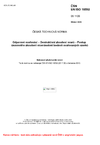Vánoční provoz a PF 2026
Vážení zákazníci,
aby bylo možné dodat objednané zboží před začátkem vánočních svátků, odešleme poslední várku zboží v tomto roce v pátek 19. prosince. Objednávky došlé po 10. hodině 19. prosince odešleme až 5. ledna 2026. Od 19. prosince do 2. ledna taktéž nebude možný osobní odběr objednaných norem.
Děkujeme za váš zájem v tomto roce,
přejeme vám hodně zdraví, pohody a úspěchů v roce 2026.
ČSN EN ISO 18592 (051109) Aktuální vydání
Odporové svařování - Destruktivní zkoušení svarů - Postup únavového zkoušení vícenásobně bodově svařovaných vzorků
Anotace obsahu normy
This document specifies test specimens and procedures for performing constant load amplitude fatigue tests on multi-spot-welded and multi-axial specimens in the thickness range from 0,5 mm to 5 mm at room temperature and a relative humidity of maximum 80 %. The applicability of this document to larger thicknesses can be limited by mechanical properties such as yield strength and formability of the specimen material. The thickness range for advanced high strength steels (AHSS) is generally below 3,0 mm. Greater thicknesses apply for aluminium alloys, for example.
Depending on the specimen used, it is possible from the results to evaluate the fatigue behaviour of:
- spot welds subjected to defined uniform load distribution;
- spot welds subjected to defined non-uniform load distribution;
- spot welds subjected to different defined combinations of shear-, peel- and normal-tension loads; and
- the tested specimen.
- Multi-spot specimens with which the different load distributions can be realized are the following:
a) defined uniform load distribution:
1) H-specimens for shear- and peel-loading, (welds subjected to uniform shear or peel loading transverse to the joint line);
2) single- and double-hat specimens subjected to four-point bending (spot welds subjected to uniform shear load in the direction of the row of welds);
3) double-disc specimen under torsion (spot welds subjected to uniform shear load);
4) double-disc specimen under tensile load (spot welds subjected to uniform peel load);
5) double-disc specimen under combined torsion and tensile loading;
6) flat multi-spot specimens using defined grips;
b) defined non-uniform load distribution:
1) H-specimens with modified grips;
2) modified H-specimens with standard grips;
3) modified H-specimens with modified grips;
4) flat multi-spot specimens with modified grips;
5) modified multi-spot flat specimens with standard grips;
6) modified multi-spot flat specimens with modified grips;
c) defined combinations of shear-, peel- and normal-tension loads:
1) the KS-2 specimen;
2) the double disc specimen;
d) spot welds subjected to undefined non-uniform load distribution - single-hat, double-hat and similar closed hollow sections under torsion, 3-point bending and/or internal pressure.
- The specimens and tests referred to under c) above are not dealt with further in this document, because the results obtained with these specimens are specific to the components as tested and may not be generalized or used for deriving data pertaining to the load-carrying behaviour of the welds. Results obtained with such tests are suitable for comparing the mechanical properties of the tested components with those of similar components tested in the same manner. These tests are, however, not suitable for evaluating or comparing the load-carrying properties of the welds.
- The test results of the fatigue tests obtained with component like specimens are suitable for deriving criteria for the selection of materials and thickness combinations for structures and components subjected to cyclic loading. This statement is especially relevant for results obtained with specimens with boundary conditions, i.e. a local stiffness similar to that of the structure in question. The results of a fatigue test are suitable for direct application to design only when the loading conditions in service and the stiffness of the design in the joint area are identical.
NOTE - Specimens are modified to take into consideration constraints or specific demands posed by design, e.g. smaller than standard overlap, smaller or larger than standard nugget diameter, and specific load distribution, thus enhancing the value of the test results for the design engineer.
| Označení | ČSN EN ISO 18592 (051109) |
|---|---|
| Katalogové číslo | 509051 |
| Cena | 440 Kč440 |
| Datum schválení | 1. 3. 2020 |
| Datum účinnosti | 1. 4. 2020 |
| Jazyk | angličtina (obsahuje pouze anglický originál) |
| Počet stran | 48 stran formátu A4 |
| EAN kód | 8596135090518 |
| Tato norma nahradila | ČSN EN ISO 18592 (051109) z července 2010 |
| Dostupnost | skladem (tisk na počkání) |


